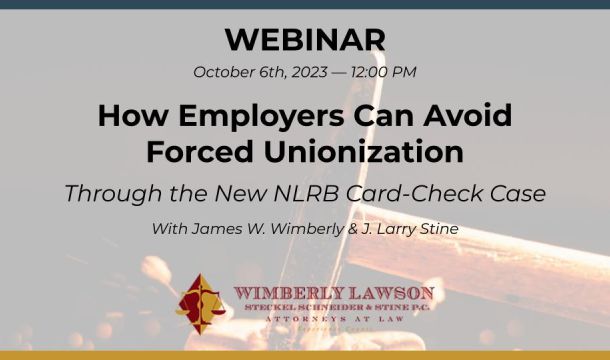Healthcare Plans Developing and Unraveling - One Attorney's Opinion
Both employers and labor unions are starting to see the effects of Obamacare kicking in, and adjusting their plans accordingly. Many stark realities are now becoming apparent that may not have been anticipated.
First, Obamacare really did not really address healthcare costs, which continue to increase. As a matter of fact, there are new estimates from the Internal Revenue Service indicating that even a “cheap” family plan will cost $20,000 a year by 2016 to cover two adults and three children. At least for 2014, employers will not be required to provide dependent coverage as part of “minimum essential coverage” to avoid penalties under the new law. However, the requirement of providing dependent coverage will kick in during 2015, at least under current regulations.
Labor unions, once a stanch supporter of Obamacare, now have serious doubts about it. A recent article in a union publication is entitled “Union Health Plans Will Suffer Under Obamacare.” The reason labor unions are becoming particularly concerned about Obamacare is that union healthcare plans (often called “multi-employer plans”) generally require all employees to participate, and employers to contribute for all employees. While this structure is supposed to drive down the per-employee healthcare cost, it has no similar savings to the employer and yet, employees would not have regular (and cheaper) access to the state exchanges, because the employer under the union-run plans may be providing “minimum essential coverage.”
As a result, with the union-run healthcare plan approach in Obamacare, employers are disadvantaged because they are paying for all employees and the employees themselves are disadvantaged because they do not have regular access to the state exchanges and the various available tax credits. Further, employers will be disadvantaged because they will not have access to the insurance market available through the exchanges, or the ability to simply stop offering coverage and provide their employees with money to assist in buying coverage on the state exchanges.
Even when an employer elects to be penalized by opting out of healthcare coverage, discontinuing coverage may be cheaper for the employer than any type of union-run plan. Without a union plan, employees can purchase their own coverage at the state exchanges at reduced rates, and with tax subsidies. Furthermore, an employer may provide an employee the money necessary to purchase the coverage on the state exchanges, and even throw in an extra amount for the workers’ increased taxes. In the process, employers can still save about half of their healthcare costs.
Labor organizations are also concerned about the fact that, with government healthcare plans available, one of the main reasons to unionize has gone away. Much like years ago when the various employment laws took away many of the reasons to unionize, the availability of government-run healthcare means that the promise of a union contract contributes nothing towards healthcare, and indeed, may really be a detriment to employees.
Further, unionized employers now have every incentive to get out of their union-run healthcare plans, and possibly out of the union itself. The employees may have the same incentive, since they see opportunities available in healthcare in the state exchanges that are less costly and more beneficial than those under the union-run plans.
Large employers (with 50 or more full-time employees) who intend to continue their own healthcare plans after 2013 are now realizing they need to pay a lot of attention to whether they are maintaining “minimum essential coverage under an eligible employer-sponsored plan” and thus avoiding the penalties. If minimum essential coverage under an eligible employer-sponsored plan is not maintained for 95% of the employer’s entire workforce, the employer may be liable for non-deductible penalties of $2,000 per employee for nearly all of its workforce in the U.S. This requirement to maintain “minimum essential coverage under an eligible employer-sponsored plan” is particularly important as many employers are experimenting with other variations of the healthcare plans, including individual healthcare accounts and the like, that may or may not provide the type of coverage that will avoid the penalties. Further, employers may need to review whether their plans have maintained grandfathered status. Unfortunately, many employers have relied on their insurance company, insurance brokers, and third party administrators to do all the technical things necessary to maintain grandfathered status, and often the necessary steps have not been taken. It is a fairly open question as to whether plans can be retroactively amended to take the necessary steps to maintain grandfathered status.
Another often overlooked fact is that even when employers maintain “minimum essential coverage under an eligible employer-sponsored plan,” they nevertheless may be liable for a penalty in circumstances where the premiums the employees must contribute exceed 9.5% of their household income or where the employers’ plans do not provide minimum value (which is determined by the federal government). For each employee who goes to the state exchanges in such circumstances, the employer may have to pay an additional $3,000 per year in penalties. At least in 2014, the speculation is that not many employees will go to the exchanges, because the penalty (which is unlikely to be collected) is only $95.00 (or 1% of income, if greater) per adult for each employee that has not signed up for coverage for the entire year. The penalties go up for 2015 to $325 (or 2% of income, if greater) per adult, which may cause more employees to participate in the employers’ healthcare plans and/or go to state exchanges for coverage. Also, the automatic enrollment provisions will likely kick in sometime in during 2014 for employers with 200 or more full-time employees, which may cause more employees to get coverage under the employers’ own plans.
Questions? Need more information? Call Jim Wimberly, Jim Hughes, or Ray Perez at (404) 365-0900 or e-mail them at jww@wimlaw.com, jlh@wimlaw.com; rp@wimlaw.com
Related Content
Get Email Updates
Recent Content

NLRB to Seek Rescission of past Discipline Imposed under Overbroad Employer Work Rules

Do Drive Cam Cameras inside Trucks Violate Employee Rights?

Amazon Considers Risk When Investigating Employee Misconduct

Latest NLRB Attack Goes beyond Non-Compete Agreements to Reach Outside Employment

NLRB Board Addresses BLM Insignia at Work




